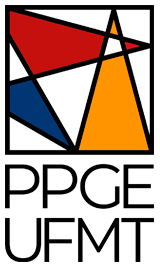O Que é um Texto? (Parte 1)
DOI:
https://doi.org/10.29286/rep.v17i35.496Palavras-chave:
Semiótica do texto. Ensino matemático. Teoria da complementaridade.Resumo
O que é um texto? À primeira vista, esta pergunta pode parecer curiosa para alguns. Afinal de contas, aqui nós nos preocupamos com livros didáticos de Matemática, e isso deixa parecer que uma pessoa sabe o que é um texto matemático em um livro didático. Mas, mesmo sendo o mais importante “instrumento” do ensino na matemática como nas outras disciplinas, o livro parece um desconhecido. Poucos livros didáticos são configurados de acordo com normas cientificas. Os maiores problemas resultam do fato que quase ninguém percebe que precisamos de tipos diferentes de textos para tarefas variadas e que mesmo assim o texto não pode nem substituir o diálogo vivo nem ser excluído ou ignorado do ensino, pois os alunos precisam tanto da comunicação viva como da oportunidade de refletir individualmente sobre o conhecimento.
What is a Text? (Part 1)
Abstract
What is a text? At first glance, this question may seem curious to some. After all, we are concerned with mathematics textbooks for school here, and it would seem that one knows what a text in a mathematical textbook is. But even though textbooks remain to be the most important “instruments” of teaching few of them seem designed by scientific insights or standards. The greatest problems result from the ignorance that different types of goals require different types of texts. Texts could neither substitute personal communication nor could they be excluded from classrooms. The students need as much the living example of knowledge, as they must have opportunity of constructive rumination on their own, individually. Keywords: Text semiotics. Mathematical education. The concept of complementarity.
Downloads
Referências
ATHEN, H. et al. Mathematik heute 7. Hanover: Schroedel, 1979.
ATIYAH, M. ‚Wandel und Fortschritt in der Mathematik‘. In: OTTE (Ed.): Mathematiker über die Mathematik. Berlin: Springer, 1974.
BALLSTAEDT, St-P. H. MANDL. W. SCHNOTZ, and S. TERGAN. Texte verstehen, Texte gestalten. München: Urban and Schwarzenberg, 1981.
CHURCHMAN, C.W. Philosophie des Managements. Freiburg, 1973.
ERSHOW, E.P. and KNUTH, D., (Eds.). (1981), Algorithms in Modern Mathematics and Computer Science, Springer, Heidelberg.
FISH, S. Is There a Text in This Class?, Cambridge, U.S.A., 1980.
FREEDMAN, D. et al. Statistics, Norton, New York, 1978.
GOMBRICH, E.H. ‘The Visual Image’, in 73rd Yearbook of NSSE, Chicago, 1974. p. 241-270.
HAYEN, J. et al. Gamma 8, Stuttgart: Klett, 1979.
HILBERT, D. ‚Über das Unendliche‘. In: Hilbertiana, Darmstadt. 1965.
HIRSCH, E.D. Validity in Interpretation. Yale University Press, 1967.
KEITEL, Ch., OTTE, M. and SEEGER, F. Text-Wissen-Tätigkeit: Das Schulbuch im Mathematikunterricht, Königstein/Ts, 1980.
KNUTH, D. ‚Algorithms in Modern Mathematics‘, In: Ershov and Knuth, 1981. p.82-99.
LOTMAN, J.M. Die Struktur des künstlerischen Textes, Frankfurt: Suhrkamp, 1973.
MATHEMATIK 6: Berlin: Verlag Volk und Wissen, 1976.
NEISSER, U. Cognition and Reality. San Francisco: Freeman and Co., Freeman and Co., 1976.
OTTE, M. (1980), ‘On the Question of the Development of Theoretical Concepts’, in Communication and Cognition 13, n. 1.
______ .’Das Schulbuch in Mathematikunterricht’, Der Mathematiklehrer n. 3, 1981, p. 22-27.
______ . What Relevance Has the ‘Problem of Texts’ for Mathematics Education and Its Understanding?, Occ. paper n. 15, 1981, IDM Bielefeld.
______ . ‘Ways of Knowing and Modes of Presentation’. In: Moyens et medias dans 1‘Enseignement des Mathematiques. XXXIVe Rencontre, Orleans 1982. p.41-69.
______ . ‘Textual Strategies’, For The Learning of Mathematics n. 3 (3), 1983. p. 15-28.
PATTEE, H. H. ‘Discrete and Continuous Processes in Computers and Brains’, in Conrad, Güttinger and Dallin (Eds.): Physics and Mathematics of the Nervous System. Lecture Notes in
POLYA, G. Schule des Denkens. München: Francke Verlag, 1967.
QUINE, W.V. Ontological Relativity and Other Essays, Columbia: University Press, 1969.
WANG, W.S.-Y. Human Communication: Language and its Psychological Basis: W.H. Freeman, 1981.
Data de recebimento: 25/03/2008
Data de aceite: 01/07/2008






















































